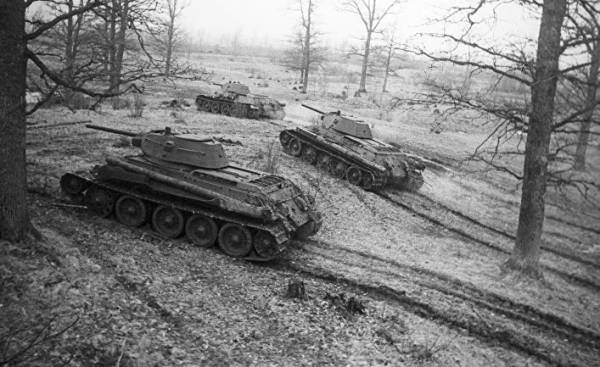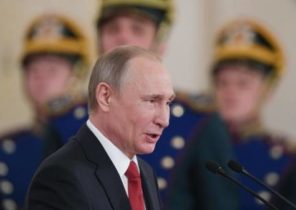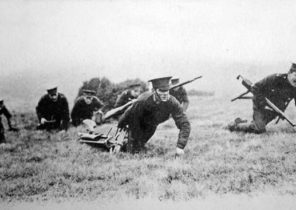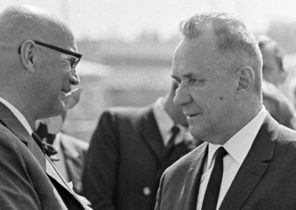
The North-Western part of Ukraine in 1941 was not easy for a tank battle terrain. Except for a few narrow and polarity highway, vehicles can move only via dirt roads that passed through the hilly and forested area, abounding in small marshy rivers and swamps. But it was there in the first week of the German invasion of the Soviet Union held a tank battle with up to thousands of armored vehicles. The battle that took place in between the towns of Lutsk, Rovno, and Brody triangle, was a harbinger of the brutal tank battles on the Eastern front.
On 22 June 1941, 1st Panzer group, which became the vanguard of army group South broke through the Soviet defensive positions near the border town of Volodymyr-Volyns’kyi at the junction of the 5th and 6th armies. As a result, skilled tactical manoeuvre is formed a gap with a width of 40 kilometers, which allowed the triumphant troops of the Wehrmacht to start pushing deep into Soviet territory. The Soviet 5th army under the command of major-General Potapov took the brunt of the advancing enemy troops, desperately trying to slow down the rate of advance of the German army.
Operational plans of the Wehrmacht foresaw the rapid advance towards the Ukrainian capital of Kiev, the capture of the city and onto the banks of the Dnieper. After performing this task, the German troops were to turn South and move along the Dnieper river, surrounded the main forces of the southwestern and southern fronts (army groups). Capture of Lutsk, situated at an important intersection of roads that would allow mobile units of the German army to break through flat terrain and start moving to Kiev in two areas: Lutsk-Rovno-Zhitomir-Kiev and Lutsk-Dubno-Berdychiv-Kiev.
Impossible orders
At the end of the first day of the war, the commander of the southwestern front, Lieutenant-General Kirponos had received from the Soviet State defense Committee instructed to immediately conduct an offensive in the direction of Volodymyr-Volynskyi, to destroy operating in the area German troops and by the end of June 24 to take the town of Lublin. Lublin was located in German-occupied Poland on the removal of 80 kilometers, and it made Kirponos to doubt that the Soviet high command to understand the current border situation.
Realizing that he posed an impossible task, Kirponos, however, was obliged to execute the order received. Standing before him was two-fold problem. First, the situation in the Soviet defense was not sustainable; and secondly, five mechanized corps intended for a counterattack were dispersed across North-Western Ukraine. Some parts had up to three days to arrive in the combat area. Therefore, all five mechanized corps had to enter into battle separately, and the interaction between them could be minimal or completely absent.
Tight deadlines did not allow Kirponos to concentrate their forces and properly prepare for the counteroffensive. Even more the situation was aggravated by the fact that many parts of the Soviet mechanized corps were mechanized in name only. Many regiments of motorized divisions was no wheeled transport and artillery regiments are chronically short of trucks. In the army there was an acute shortage of means of communication, especially of artillery and armor-piercing ammunition.
When the Soviet mechanized formation began to move towards the border, the German air force began to strike with relentless and never-ending air strikes on columns of armored vehicles stretching along the narrow roads. Sometimes Soviet, a driver who desperately tried to hide from the enemy planes were stuck on difficult terrain and were forced to leave or to undermine their cars. The decline of armored vehicles because of frequent breakdowns began to reach alarming proportions. Due to losses from air strikes and equipment failures of the Soviet tank units went into battle with less than 50 percent of combat strength.
However, with 1st Panzer group came to reconcile the powerful forces, nearly twice the number of tanks, which had at its disposal Lieutenant General Paul Ewald von Kleist. Before the war, consisting of five Soviet mechanized corps had about 3 tanks 140. Despite serious non-combat losses during the nomination of armored forces, they had a significant numerical superiority over the tanks 618, commanded Kleist.
In the afternoon of 24 June the 19th Panzer division from the composition of the 22 th mechanized corps made contact with the advancing German troops to the West of Lutsk. This division suffered heavy losses from attacks by the Luftwaffe at the time of nomination and have suffered from chronic equipment breakdowns. The remainder of her 45 light tanks T-26 and 12 armored vehicles were consolidated into one regiment of the interim and joined the battle after a short artillery barrage. The battle with units of the German 14th Panzer division lasted two hours; during this time the Soviet troops which remained had lost their machines and were forced to withdraw almost 15 kilometers to the West of Lutsk.
This battle costly to both sides. Killed the corps commander major General Kondrusev, and the commander of the 19th Panzer division was wounded. All the commanders of the regiments in this division either died or were wounded. But as a result of this sacrifice, the 14th Panzer division the Germans also suffered heavy casualties and failed to take Lutsk.
In the night from 24 to 25 June, the formation of the two other divisions began to take positions near the remains of the 19th Panzer division. There was a great shortage of fuel, but the Soviet officers were able to partially solve this problem by draining the fuel from wrecked cars and distributing it among the remaining crews.
German tanks against the KV-2
The Soviet part was clearly nebogatova, when the Germans during the morning of the offensive took the initiative. During a fierce battle, which lasted till night, the Soviet troops fought for every inch of ground. The Germans ruthlessly destroys the weaker light vehicles T-26 and BT, faced with a dozen of the monstrous Soviet heavy tanks KV-2. The German shells just bounced off the thick armor of the clumsy and high towers KV-2. In those few cases where KV-2 was able to use his 152-millimeter howitzers, they managed to temporarily stop the German advance.
The best tactic of the German defense against these monsters was waiting when the Soviet KV-2 will run out of ammo and fuel. In one case, the crew of KV-2, which jammed the turret, ended shells, and was running out of fuel, drove his car from a steep Bank into the river, and the driver jumped out of her at the last moment. The few tanks KV-2, actually joined the battle, more suited as a self-propelled artillery, and have become nothing more than a minor inconvenience of a local character for the German armored forces.
The Germans capture Lutsk and Dubno, and then turn South
At sunset the 13th Panzer division, conducted a successful flanking attack and leaving behind burning suburbs of luck, captured the city and forced the Soviet troops to leave. Taking the desperate fighting, the 22nd tank corps won the most valuable time for a day and a half holding promotion two German corps. This has enabled the Soviet 9th mechanized corps to arrive and deploy in battle formations in the area Exactly, which is 65 kilometers East of Lutsk.
Continuing the deployment of troops in the gap at the junction of the 5th and 6th armies, the Germans began to move South from Lutsk in the direction of the towns of Brody and Dubno. The night they captured Dubno. Furnished in 5-th army was really desperate. Many of its parts were surrounded and fighting for survival, being scattered all over from the border to luck. The remnants of the 22nd mechanized corps in disarray retreated on the road in the direction Rivne, spreading panic along the way. Partly to restore order failed only through the direct intervention of officers from the headquarters of the 5th army.
All day on 26 June, the Germans tried to break through to Exactly the road Lutsk-Rivne and Dubno-Rovno. After failing to succeed because of the strong resistance of the 5th army, they changed the direction of advancement, to launch an offensive on minor roads in the city Jail. The fall of the Burg would have allowed the Germans to encircle Soviet forces defending Exactly, or at least force them to retreat.
19th mechanized corps under the command of major-General Filenko joined the battle to counter the new threat and struck the 11-th and 13-th tank division, who led the German offensive. In the afternoon, the Soviet 43rd tank division, marching in the vanguard of the attack, made their way to the Eastern outskirts of Dubno. German anti-tank artillery inflicted heavy losses on light tanks T-26 formed the basis of the 19th mechanized corps.
Showing impressive tactical skill, the German command reacted to this new threat and counterattacked the stretching of a Soviet tank division. Caught between a hammer two German infantry divisions and the hard place of the two Panzer divisions, major-General Filenko gave his body the order to withdraw to their original positions near Exactly. By nightfall, the fighting died down, and Dubno remained in the hands of the Germans.
Tanks T-34 and KV-1 come as a surprise to the Germans
When around Dubno was a fight, in the battle to take two Soviet mechanized corps — the 8th and 15th. These strong corps attacked from the city of Brody, moved 35 miles and cut the German lines of communication around the small village of Berestechko, 45 kilometers West of Dubno. Some time the Soviet forces had a real opportunity to encircle the Germans in Dubno.
8th and 15th mechanized corps were the most powerful groups, which still faced the Germans. Despite the losses from air attacks and breakdowns of equipment in these buildings has remained around 1 500 tanks. More importantly, their composition was approximately 250 new medium tanks T-34 and heavy tanks KV-1. Unfortunately for the Soviets, T-34 and KV-1 was not concentrated in large battle formations. They acted in two buildings consisting of small units.
The appearance of T-34 and KV-1 became for the Germans a complete surprise. German tank crews quickly discovered that their new enemies in many respects significantly superior to the tanks of the Wehrmacht.
Most of the guns of the German field artillery was ineffective against these tanks. However, high performance when firing at tanks direct fire showed the 88-millimeter anti-aircraft gun.
German tactics bearing fruit
Commanders of the German armored units had to be creative and develop new tactics of struggle against more powerful Soviet tanks. Using the experience, skills and a higher level of training of mechanics-drivers and German tank crews maneuvered, leaving from under fire of the T-34 and KV-1, and at the same time, destroyed the lighter BT-5, BT-7 and T-26. German field artillery, possessing greater mobility, provided close air support and weakened the onslaught of Soviet tanks. German tanks T-3 and T-4, to cope with the lighter Soviet tanks retreated, and then attacked the T-34 and KV-1, hitting their vulnerable side and to the rear.
Higher rate of fire of the Germans was the decisive factor that allowed the tank to successfully counter their superior technical characteristics of Soviet tanks. For every shell fired by the Soviet tanks, the Germans usually answered with two or four return shots. A higher density of fire often led to hits in vulnerable places, such as barrels of guns, rotary mechanisms of towers and tracks. Soviet tanks, immobilized combat damage, mechanical breakdowns and impassable terrain, they came under heavy enemy fire. German engineers showed a lot of courage, approaching the motionless, but still shooting Soviet tanks, and destroying their subversive charges.
Often, inexperienced Soviet drivers were moving on the easiest routes, even if they became a target for enemy fire. So, many of them led their tanks on the ridges of mountains and hills, becoming easy prey for German gunners.
Behaved Soviet tank crews in completely different ways. Someone out of the fight or throwing their tanks at the slightest failure. And someone fought with doomed determination, even in cases when this is not required in a combat situation, and when the victim’s tank gave nothing.
An important factor contributing to low efficiency and large losses of the Soviet armored forces was the lack of radio communication. Below battalion level Soviet tank crews had almost no radio communications. Messages to a greater distance the line of sight passed motorcyclists, and commanders of tank companies and platoons had to pass the signals flags and hands. As a result, Soviet tank crews tried to get closer to commanding tanks to better examine the signals and act on them. Losing commanders, Soviet tankers, which have been little taught to take the initiative in battle, became easy prey for the more experienced German tank.
Inefficient T-35
Mingling with other Soviet machines, in the direction of the Germans moved 41 the monstrous heavy tank T-35. This machine had five towers and a crew of 10 people. It was too heavy and too slow. These obsolete tanks often broke down and stopped, not even entering in contact with the enemy.
In early July, the command of the 8th mechanized corps was sent to the headquarters of the South-Western front report on the operations of the corps. It was reported that all 45 tanks T-35 lost. Four cars were thrown, when advancing German troops occupied the places of permanent deployment of the 8th corps, in 32 tanks suffered mechanical failure, and two were shot down by German aircraft at the time of nomination. The battle joined, only seven T-35, and all of them were destroyed by the enemy. Because in Soviet army almost no means for the evacuation of unserviceable military vehicles, all T-35 were lost.
The battle of Berestechko: a fiery nightmare
Battle near the town of Berestechko turned into a fiery nightmare, devouring men and machines on both sides. The German air force constantly bombed the Soviet positions. In one airstrike, pilots of the Luftwaffe managed to wound directly on the command post of the commander of the 15th mechanized corps of major-General, Carpet.
In his military diary chief of the General staff of the German land forces General Franz Halder noted: “On the front of army group “South” is still ongoing heavy fighting. On the right flank of the 1st tank group of the 8th Russian tank corps are deeply penetrated into our location… It’s… caused a big mess in our rear in the area between Brody and Dubno. The enemy threatens Dubno from the southwest, which for the large stocks of weapons and equipment in Dubno highly undesirable”.
Creating Germans serious problems, Soviet armored units were worn out and weakened. Loss of personnel, tanks and military equipment had reached alarming proportions. Although Lieutenant-General Kirponos begged the commanders to give him permission to withdraw their forces to rest and recharge, the Rate ordered him to continue the offensive.
Morning of June 28 the Germans launched their own counteroffensive against exhausted Soviet troops. German intelligence managed to discover an open left flank of the 8th mechanized corps and four divisions went on the offensive, bypassing the enemy positions. By evening, all three divisions from the 8th mechanized corps were surrounded. They received orders to go on break. Two divisions managed to break through, but the 34th tank division was completely routed and lost all their tanks and other machines. Died and the division commander, Colonel Vasily. To escape from the boiler only managed about 1 000 men under the command of commander of the 8th mechanized corps Popiel. For day of fighting corps lost more than 10 thousand people of staff and 96 tanks, and more than half of artillery.
Heavy losses were suffered and 15th mechanized corps, and by the night of 29 June, the two corps finally got the permission to a departure to the South of the city of Brody. The Soviet armies have entered into a severe rearguard action, trying to break away from the enemy. On the evening of 30 June the German air force struck a powerful blow on the columns of Soviet vehicles, retreating in the direction of Zolochiv, turning the by-pass highway around the city in a huge funeral pyre of military vehicles.
Rokossovsky, trying to stem the retreat
At a time when the 8th and 15th mechanized corps into battle, the 9th mechanized corps finally was able to concentrate for its attack on Dubno. Appearing at the forefront, the future Marshal of the Soviet Union major-General Rokossovsky watched as the soldiers of the red Army in large numbers wandering aimlessly through the forests. He promptly ordered several officers from its headquarters to arrest stragglers from their units soldiers, arm them to the extent possible and return the vagrants in the system.
Rokossovsky was discouraged when I discovered that the deserters hiding a few senior officers. In his memoirs he wrote that he had a strong temptation to shoot one of the “alarmists” — Colonel, with whom he had a conversation in a raised voice. Hard as steel rokossovskii, a survivor of pre-war Stalinist purges in the ranks of the officer corps, allowed him to redeem himself and lead the fight temporarily formed unit. On the morning of 27 June it was the turn of Rokossovsky to enter in the battle of Dubno the case in which there were only 200 light tanks. The 9th mechanized corps was immediately met with strong resistance of the enemy, and the Germans began to probe his unprotected flanks, seeping into the joints between the parts and endangering the environment of the whole body.
Like the commander of the 19th mechanized corps, Rokossovsky night was forced to give the order to retreat without reaching their goal. But thanks to his attack managed to contain the advance of the German troops and weaken the burden on the 19th mechanized corps, retreating in the direction of Rivne.
Together with bloodless infantry units of the 5th army’s two mechanized corps another day stubbornly defended Smoothly, despite all the attempts of the Germans to take the city. But their courage and bravery were in vain. On the evening of 28 June, 11th Panzer division the Germans captured the city Jail and created a bridgehead on the opposite Bank of the river Goryn. Exactly defending Soviet troops suddenly faced with an unpleasant ability to stay on the wrong side of the river, as the German portion broke into their rear echelons. The red Army reluctantly left Exactly and went away on the other side of the river, moved to defense in the area Tuchin — Hoscha.
Questionable Soviet strategy leads to huge losses
The fall of the prison, the battle in the “bloody triangle” actually came to an end. Exhausted Soviet troops held the front at the turn of the Goryn river until 2 July, after which he was forced to retreat even further.
By July 7, five Soviet mechanized corps, which participated in the fighting in the “bloody triangle” of pre-war combat strength 3 140 tanks were only 679 cars. The Soviet 5th army had been decimated, but not defeated, and most of its parts were not destroyed, although suffered huge losses. 5th army, clinging to the southern edge of the Pripyat marshes, continued to pose a threat to the left flank and rear the German troops who were advancing on the capital of Ukraine Kiev. It was such a painful thorn in the German side, Adolf Hitler on 19 July, 1941 his Directive No. 33 specifically demanded to destroy this group.
After the fall in September, Kiev the 5th army was finally defeated, and its commander, major-General Potapov was captured. He managed to survive the war in a pow camp. Lieutenant-General Kirponos, bravely trying to strengthen his crumbling South-Western front, was killed during the breakout from the encirclement. General Rokossovsky returned to this place in 1944, but this time his victorious T-34 tanks drove the exhausted enemy troops to the West in the direction of Germany.
Than explained to the Soviet high command is so haphazard and indiscriminate application of the five mechanized corps? Did the generals had not grasped the seriousness of the situation and how futile attempts to hold an advanced position? It is not excluded that the Soviet high command, relying on incomplete or false information, was under the impression that this is not a major invasion, and the border was a provocation. In the end, the Soviet Union in the late 1930s, years of fighting in two border conflicts with Japan, but none of them escalated into full-scale war.
Maybe the Soviet leadership were fully aware of the danger, but wanted to reserve time for a General mobilization. Every day that his own blood has won the advanced echelons, gave the opportunity to build reserves, arm them and send into battle.
Probably, the truth, as always in such cases, lies somewhere in the middle. But anyway, tank battles in the “bloody triangle” showed the Germans that the Soviet Union is not a “colossus with feet of clay”. Although the 5th army and five Soviet mechanized corps had failed in its task and destroyed a mobile army group of Germans, they managed for nine days to delay the German offensive.
The delay from June 24 to July 2, seriously disrupted the German plans for military action in Ukraine. After easy victories in Western Europe, the resistance of the Soviet soldiers and their willingness to defend every inch of land became for the Germans a nasty surprise. Ahead of them waited a long and painful war.







